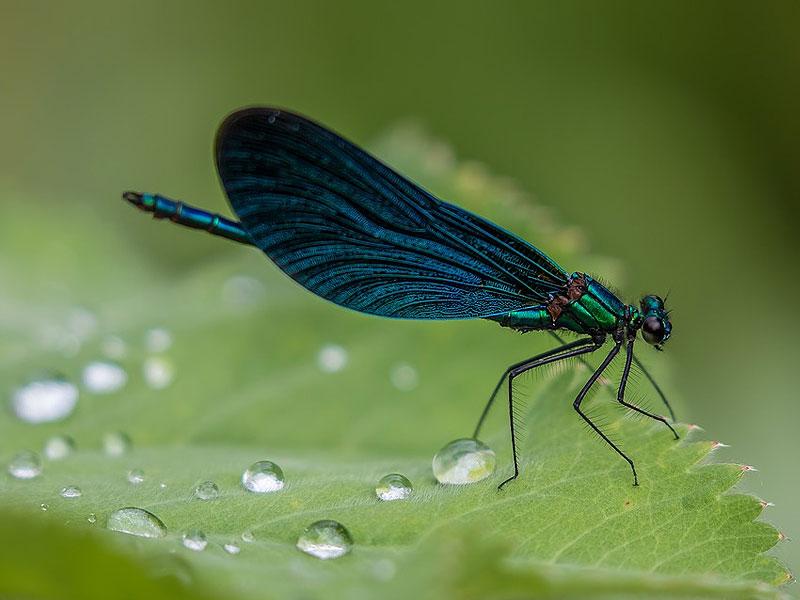Dragonflies can eat hundreds of mosquitoes every day to help keep your backyard mosquito free. Here are 5 easy-to-grow plants that attract dragonflies to your garden.
There’s a joke around my neighborhood… we have two seasons – Winter and Mosquito. In order to enjoy the outdoors without constantly swatting at the little buzzers or lathering yourself with mosquito repellent, you need to reduce the population of mosquitoes in your yard.
There are chemical ways to do that, but if you don’t like the idea of spraying your back yard with insecticides, knowing the mosquitoes will find their way back into your yard and be buzzing in your ears within days, there is a much more attractive alternative that can help.
To be honest up front, very few things will eliminate mosquitoes, except – perhaps – screening yourself into a protective bug-free bubble. However, there are natural ways that you can help minimize their annoyance so that you can still enjoy the outdoors and nature.
After all, nature often takes care of nature, and nature can be beautiful. Therefore, it stands to reason that there would be some beautiful things in nature that you can help reduce the number of mosquitoes buzzing around your back yard. And one of those is by attracting Dragonflies.

Not only are dragonflies an attractive (and almost mythical) insect, they are harmless to humans, and are known to consume their own body weight in bugs every half hour. In fact, more than 90% of a dragonfly’s diet consist of those pesky mosquitoes.
This means that they can eliminate hundreds of mosquitoes each and every day. And more dragonflies equate to more mosquitoes that become food instead of making YOU food.
If you find yourself being swarmed by mosquitoes, ask yourself when the last time was that you saw a dragonfly around. If you haven’t noticed many, that’s probably why the mosquito population has managed to flourish.
The next best part is that the way you can attract dragonflies is by planting some lovely plants that attract dragonflies in your yard. That’s not such a hardship, is it?
Pond plants do a really nice job of attracting dragonflies, but that also means installing a pond. For the purpose of today’s post, we’re going to focus exclusively on land-plans that can be added to nearly any garden to help bring in the dragonflies and help keep out the mosquitoes.
Black-Eyed Susan

Black-eyed Susans (otherwise known by the technical name of Rudbeckia hirta) are native to North America and are one of the most popular wildflowers ever grown. You can often find them blanketing open fields, creating a show of golden-yellow beauty.
Black Eyed Susans can grow over 3 feet tall and bloom from June to September or early October with flowers than span 2 – 3 inches. They group really nicely into bunches or can be planted along a fence-line to create a showy border.
Black-Eyed Susans are very popular among the insect world and will attract dragonflies and butterflies as well as other pollinators. That’s one of the things that makes them one of the most popular among the plants that attract dragonflies.
Meadow Sage

Meadow Sage (also known technically as Salvia pratensis) is not only useful for its dragonfly attraction qualities, but it also creates a rich display of colorful spikes in the early summer, as they begin blooming in May and keep blooming all the way through September if cared for properly. Medium in size, the flowers tend to be a deep violet-blue.
Meadow Sage is very easy to grow, hence why it is also often referred to as Wild Sage, and dragonflies love this pretty Indigo plant.
Sage is also known as one of the plants that help to repel mosquitoes, so this particular beauty serves double duty.
Swamp Milkweed

Swamp Milweed (technical name Asclepias incarnata) Is very well known for attracting butterflies, but it also does just a good a job at attracting dragonflies.
These beautiful flowers, with show clusters of pink and purple flowers, are native to most of the Continental US as well as Eastern Canada. They love full sun and can grow quite large, reaching 4 – 6 feet, and bloom through July and August.
White Yarrow

White Yarrow (which also goes by the technical name of Achillea millefolium) is a graceful wildflower that features flat customers of creamy-white flowers. The fern-like foliage is pleasantly aromatic and disease resistant, making it a lovely and easy-to-grow addition to your dragonfly garden.
These prolific bloomers like full sun and some varieties will bloom from late spring well into the fall.
Joe-Pye Weed

Joe-Pye Weed (known among horticulturists as Eupatorium purpureum) has an unfortunate name but does a lovely job of attracting dragonflies to your garden. Most people spend their summers trying to rid their garden of weeds, but this particular variety is one you should consider adding to your landscape.
This hardy plant produces pale purple flowers from mid-summer all the way until the fall, creating a wonderful attraction for dragonflies and a showy display of color for you.
Combine these 5 dragonfly loving plants with plants that help repel mosquitoes, and you should be able to drastically reduce the mosquito population around your home.



hi there. Is Rudbeckia Fulgida aiton the same as Rudbeckia hirta? Trying to attract dragonflies to my yard.
Thank you for the very informative site.
Jun M.
Rudbeckia fulgida Aiton is better known as Orange Coneflowers and Rudbeckia hirta is better known as Black-eyed Susans. Although they are part of the same plant genus, so they should have very similar dragonfly attraction capabilities, I don’t have enough experience with the Coneflowers to say for sure.
Thanks, Paul